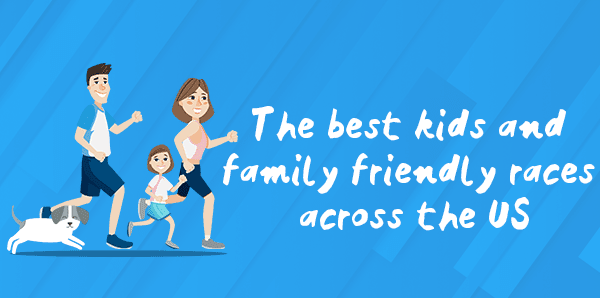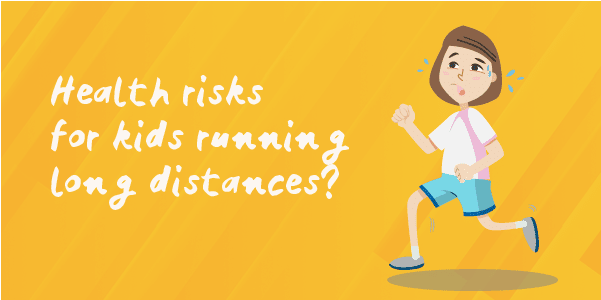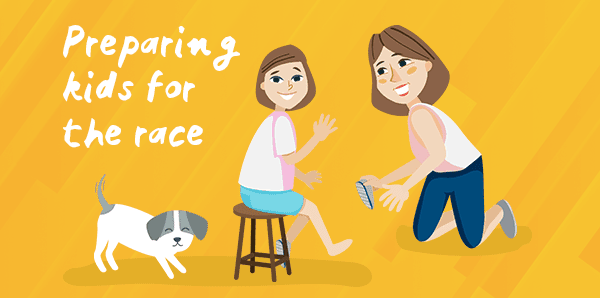Kids Running - Best Kids & Family Friendly Races across the US
The number of obese children may rise to 70 million by 2025. That’s more than double the 32 million figure recorded in 1990.
It’s not just about weight. Obesity is linked to major health problems like diabetes, heart and joint problems, disability, and even some cancers. The World Health Organization recommends at least 60 minutes or more of physical activity for school going kids but only 21% of 6 to 19 years old get to the bare minimum mark.
Rather, a Kaiser Family Foundation study revealed that children spend more than 7 hours a day on screens.
These are alarming numbers.
Inactive childhood will usually lead to inactive adulthood simply because inactive children will develop weaker bones and muscles. And all this obesity and inactivity can result in shorter lifespans.

This is why getting kids to participate in healthy physical activities is more important than anything else. If not, you could be setting them up for a range of physical and mental health problems, behavioral issues, low confidence, and poor academic performance.
Several organizations and governments are promoting physical activities and running events for kids. These events are a fun and easy way to take your kids out and motivate them to build healthy habits like running.
You can find a race or event in your city in our regularly updated database of kids and family-friendly races.
- Want to add a kids or family friendly race to the database? Contact Sadi at sadi@runrepeat.com.
Benefits of running for children
Exercise holds a lot of benefits for children. While there are several kinds of exercises or sports, running is probably the most convenient because you don’t need a lot of equipment, space, or teams to play. Let’s have a look at just some benefits running holds for your kids.

Enhances brain power and cognitive abilities
Exercise has a positive effect on cognitive skills and memory. There is ample evidence that exercise can induce cognitive improvements. One study found that 10 minutes of daily high-intensity exercise for 6 weeks can have a positive effect on the cognitive abilities of children. Scientists examined over 300 children between 7 and 13 years of age. It also discovered that high-intensity exercise positively affects children who needed it the most. These children had poor cardiovascular health and had gene variants linked to poorer cognitive skills.
Apart from improving memory and thinking skills, exercise is known to increase the size of a child's brain and improve academic performance. Research confirms that in physically fit children, the volume of grey matter is greater in the brain’s temporal and frontal regions along with the calcarine cortex. All of these brain parts are crucial for executive function as well as motor skills, learning, and visual processing.
Researchers maintained that physical fitness in children is directly associated with significant improvement in mental capabilities. The study also found that exercise boosts grey matter in two regions. These are known as inferior frontal gyrus and superior temporal gyrus, which both play an important role in reading and language processing.
Boosts energy levels:
Running or any other type of exercise can boost quickly energy levels in children. Evidence shows that regular exercise tackles the conditions of low energy and fatigue. Research claims that exercise can improve the feelings of low energy and fatigue in people. For example, this study found that exercise can be beneficial for those individuals who experience persistent fatigue without having any medical condition or having diagnosed with unexplained fatigue syndrome.
The study observed that both low and moderate-intensity fatigue can elevate energy levels. The study examined the effects of exercise for 6 weeks and found that it helps a lot with the energy levels in sedentary individuals.
Helps with sleep quality:
Good quality sleep is extremely important for kids’ physical and mental growth. The term sleeping like a baby is used for a sound and peaceful sleep but even babies’ sleep is getting affected due to the ever-increasing screen time. The lack of quality sleep negatively affects their growth and well being.
We do not need research to confirm that we can fall asleep quicker and sleep better when we are physically tired, but research does, in fact, confirm exactly that. Exercise can improve your sleep quality. The study observed that the exercise’s positive effects were more evident in the night immediately after exercise. The quality of sleep, as well as the duration of sleep, improved significantly after morning exercise as well. It concluded that exercise makes it easier to fall asleep, increase sleep time, along with improving the overall sleep quality.
Ensures healthy growth:
According to scientists, childhood physical activity can have a lifelong impact. A study examined the fitness records of 1.2 million Swedish men who were born between 1950 and 1976. It observed the subsequent progress in life and concluded that those who exercised during adolescence proved to be more successful professionally.
Many studies show that exercise improves cardiorespiratory fitness during childhood. Moreover, it is directly associated with the structure and function of the developing brain. Parts of the brain like the hippocampus, the region responsible for memory, and the prefrontal cortex, both benefit from childhood exercise the most, because these parts do not complete their formation until the early 20s.
Uplifts self-esteem:
Physical activity is also good for your child’s confidence and self-esteem. Children and adolescents face several psychological and behavioral challengers because of hormonal changes. A boost in their self-esteem can help prevent these problems from occurring or at least mitigate their effects. Scientists have found that exercise has favorable short-term effects on self-esteem in children and young people. Many small trials have supported the premise that exercise can uplift self-esteem in children.
The reason exercise can positively affect self-esteem is that physical activity imparts a sense of purpose onto a person. It makes one feel good about themselves and hence improves the self-esteem of a person.
Improves mood and creativity:
Physical activity tends to have a great impact on mood and creativity. There is strong evidence that taking part in exercise or sports can improve our mood. Studies have also proved that exercise can augment creative thinking. That is because exercise improves mood, and a good mood is crucial for creativity. This way, exercise tends to amplify creative skills as well. Anecdotal evidence also indicates that creative people use physical activity to deal with 'blocks'.
This study suggests that mood and creativity are significantly improved by physical activity. The results are favorable in patients with anxiety and depression, as well as normal individuals. As for patients with anxiety and depression, the results are better after the session and an extended exercise program.
According to the experts, exercise helps improve the mood of children by releasing chemicals that can reduce depression symptoms. Many mental health experts recommend exercise as a form of therapy. Physical activity is believed to reduce mental health issues and depressive thoughts. It has been shown to change certain neurotransmitter levels, which helps improve a person’s self-regulation.
Health risks - are there any?

Everything is good in moderation.
Running has tremendous benefits for kids but that doesn’t mean the more they run, the better it is. We have had six-year-olds participating and completing a half marathon but your child does not necessarily need to run long distances to get these benefits.
Excessive running or running long distances can be counterproductive and lead to health issues especially if you are not giving your body the adequate rest and diet to recover. According to a position statement published in the Clinical Journal of Sports Medicine, children are anatomically different from adults. They should not be considered ‘small adults’ because their anatomy and physiology are not fully mature and undergoing development.
Increased risk of injuries:
Another article published in the Journal of Athletic Training has highlighted the difference between older and younger runners. The article argues that children cannot absorb the running impact, as well as adults do. Therefore, caution should be taken regarding safe distances for young runners. Although many younger runners have completed marathons, we still need more research to confirm if it is totally safe and doesn’t cause any problem in the later years.
Researchers note that too much strain on maturing joints can result in long-term injuries to growth plates or joint cartilage. Experts also suggest that because children’s hearts are smaller, they cannot dispense enough oxygen and energy to the working muscles during long-distance running. Therefore, it is not recommended for kids to participate in events that involve running more than 10K.
Most stress-related physical injuries go away with rest and treatment. However, some lead to growth disturbance and deformity.
Inflammation and Swelling:
Inflammation and swelling are common after intense exercise. Research indicates that the body adjusts to intense exercise after regular intense training. Systemic inflammation reduces as well. However, oxidative damage can be carcinogenic, so persistent inflammation should be addressed before increasing mileage.
Kids training and race preparations:

Races for children are becoming a common thing. While the activity plays a role in evolving the child’s personality, it also comes with many health benefits. Although the distances of these races tend to be shorter, children are going to need full physical and psychological preparation. Here are a few things to keep in mind while preparing kids for a race:
Teach your kids:
Teach the kids proper mechanics. Teach them to start slowly, change up the runs every day, and run with a group whenever they can. Above all, tell them to tread softly and protect their foot muscles.
Moreover, focus on the strength of their foot muscles. Another thing a child needs to remember while taking part in a running competition is to avoid crashing down on the road. It will consume energy at the very beginning of the race.
Educate the kids about the do’s and don’ts of running. Tell them how they can avoid getting their muscles pulled and sustain energy levels until the end.
Support, don’t push
Do not push your children into something. It will create an aversion to that very thing. Support them and entice them into following you. First, make sure your child wants to participate in the activity. If he or she is not interested in the activity, they will be less motivated to focus and give their best effort.
Furthermore, do not expect your child to achieve milestones right from the beginning. Set the bar low in the early days of practice. Keep raising the goals (time, speed) gradually, and when the kid says that they are tired, allow them to stop and take a rest.
It is important to be a good role model.
This is the first rule of parenting, walk the talk. Teach your children good things by modeling it, and the same goes for running. Join them in their practice and encourage them continually.
Ensure proper nutrition and rest:
Children need proper nourishment for their growth. When they are engaging in an intense physical activity like running, they will need more nutrition. Moreover, your child needs proper food to maintain energy levels that are crucial for the victory of the child. However, do not let your children run immediately after they have eaten to avoid colic and stomach heaviness. If your child is feeling hungry, give them small amounts of food before workouts. Also, provide them with a healthy diet like vegetables or fruit. Do not let them load up, as one should run with a slight feeling of hunger.
Also, let your child take proper rest to avoid stress-related injuries.
Invest in good running shoes and clothing:
Clothes and footwear are a lot more important than you would think. One cannot give their best unless they are wearing comfortable clothes and footwear. The running gear needs to be lightweight and comfortable. Proper runnng shoes can help avoid pain or injuries so it is important to invest in quality footwear for kids.
